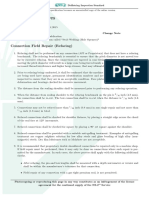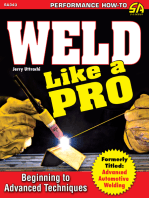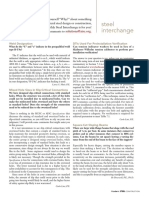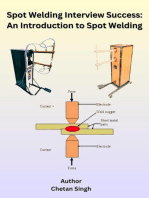0 ratings0% found this document useful (0 votes)
104 viewsWelded Splices of Reinforcing Bars: Both Contractor and Engineer Must Be Aware of Special Requirements
Welded Splices of Reinforcing Bars: Both Contractor and Engineer Must Be Aware of Special Requirements
Uploaded by
PaulWalterTorregosaThe document discusses different methods for splicing reinforcing bars in concrete structures, including lap splices, mechanical connections, and welded splices. It focuses on the requirements and considerations for using welded splices, including building code requirements. Proper splicing is important for structural integrity, and the engineer must evaluate options and ensure requirements are met.
Copyright:
© All Rights Reserved
Available Formats
Download as DOCX, PDF, TXT or read online from Scribd
Welded Splices of Reinforcing Bars: Both Contractor and Engineer Must Be Aware of Special Requirements
Welded Splices of Reinforcing Bars: Both Contractor and Engineer Must Be Aware of Special Requirements
Uploaded by
PaulWalterTorregosa0 ratings0% found this document useful (0 votes)
104 views2 pagesThe document discusses different methods for splicing reinforcing bars in concrete structures, including lap splices, mechanical connections, and welded splices. It focuses on the requirements and considerations for using welded splices, including building code requirements. Proper splicing is important for structural integrity, and the engineer must evaluate options and ensure requirements are met.
Original Title
Welded splices of
Copyright
© © All Rights Reserved
Available Formats
DOCX, PDF, TXT or read online from Scribd
Share this document
Did you find this document useful?
Is this content inappropriate?
The document discusses different methods for splicing reinforcing bars in concrete structures, including lap splices, mechanical connections, and welded splices. It focuses on the requirements and considerations for using welded splices, including building code requirements. Proper splicing is important for structural integrity, and the engineer must evaluate options and ensure requirements are met.
Copyright:
© All Rights Reserved
Available Formats
Download as DOCX, PDF, TXT or read online from Scribd
Download as docx, pdf, or txt
0 ratings0% found this document useful (0 votes)
104 views2 pagesWelded Splices of Reinforcing Bars: Both Contractor and Engineer Must Be Aware of Special Requirements
Welded Splices of Reinforcing Bars: Both Contractor and Engineer Must Be Aware of Special Requirements
Uploaded by
PaulWalterTorregosaThe document discusses different methods for splicing reinforcing bars in concrete structures, including lap splices, mechanical connections, and welded splices. It focuses on the requirements and considerations for using welded splices, including building code requirements. Proper splicing is important for structural integrity, and the engineer must evaluate options and ensure requirements are met.
Copyright:
© All Rights Reserved
Available Formats
Download as DOCX, PDF, TXT or read online from Scribd
Download as docx, pdf, or txt
You are on page 1of 2
Welded splices of
reinforcing bars
Both contractor and engineer must be aware of special requirements
BY DAVID P. GUSTAFSON
TECHNICAL DIRECTOR
CONCRETE REINFORCING STEEL INSTITUTE
P roper splicing of reinforcing bars is crucial to
the integrity of reinforced concrete. The ACI
Building Code1 states: “Splices of re i n f o rc ement
shall be made only as required or permitted
on the design drawings, in the specifications, or as
authorized by the engineer.” Great responsibility for design,
specification and performance of splices rests with
the engineer, and only the engineer who is familiar with
the structural analysis and design stress, probable construction
conditions and final conditions of service can
properly evaluate the variables to select the most efficient
and economical splice method.
Three methods are used for splicing reinforcing bars:
• Lap splices
• Mechanical connections
• Welded splices
The traditional lap splice, when it will satisfy all req
u i re m e n t s, is generally the most economical splice,
and welded splices generally require the most expensive
field labor. Howe ve r, lap splices cause congestion at
the splice locations, sometimes making their use impossible.
The location of construction joints, provision for
future construction, and the particular method of construction
can also make lap splices impractical. In addition,
the ACI Building Code does not permit lap splices
in “tension tie members,” or in #14 and #18 bars except
for compression only, when spliced to smaller size footing
dowels.
In column design, consideration must also be given to
the fact that lapped offset bars may have to come inside
of the bars above and therefore reduce the moment arm
in bending. When the amount of column vertical reinforcement
is greater than 4 percent, and particularly in
combination with large applied moments, the use of
butt splices—either mechanical connections or welded
splices—should be considered to reduce congestion,
and to provide for greater design moment strength of
the section at the splice locations.
Thus, if lap splices are not permitted or are impractical
to use, mechanical connections or welded splices
must be used. Mechanical connections are made with
p ro p ri e t a ry splice devices. Pe rf o rmance information
and test data should be secured directly from manufacturers
of the splice devices.
The purpose of this brief article is simply to answer
some of the questions concerning welded splices. Although
only welded splices are discussed here, it should
not be construed that welded splices are being advocated.
Each splice method has its advantages and suitability
for particular applications. For projects of all sizes,
manual arc welding will usually be the most costly
method, due to direct and indirect costs of proper inspection.
Building code requirements for welded splices
The model building codes, which are the basis for
many statutory building codes, have some special requirements
for welded splices. The Basic Building Code2
and the Standard Building Code3 adopt the ACI Building
Code by re f e re n c e. Except for A706 bars, the Uniform
Building Code4 prohibits welding unless the carbon
equivalent (explained below) is known. The UBC permits
the building official to waive this requirement for
minor details or repairs, provided the welding procedures
are the same as those for a carbon equivalent exceeding
0.75 percent.
Some key items included in the ACI Building Code requirements
for welded splices are: welding must conform
to AWS D1.4-79;5 in a full welded splice, as required
in a “tension tie member” or in compression, the
bars have to be butted and the splice must develop at
least 125 percent of the specified yield strength, fy, of the
bar. For tension splices where the area of the bars is
twice that required by structural analysis, the splices can
be designed for less than 125 percent fy of the bar. There
are also rules for staggering the splices, and tack welding
is not permitted unless authorized by the engineer. The
basic welding requirements given in AWS D1.4-79,
“St ru c t u ral Welding Code— Reinforcing Steel,” include
You might also like
- Subsea Rigid Pipelines – Methods of InstallationFrom EverandSubsea Rigid Pipelines – Methods of InstallationRating: 5 out of 5 stars5/5 (1)
- Method Statement For Precast Concrete WorksDocument21 pagesMethod Statement For Precast Concrete WorksBleep News100% (1)
- Bottom Plate ReplacementDocument1 pageBottom Plate ReplacementYo Wee LiamNo ratings yet
- SAES-L-109 PDF Download - Selection of Flanges, Stud Bolts and Gasket - PDFYARDocument5 pagesSAES-L-109 PDF Download - Selection of Flanges, Stud Bolts and Gasket - PDFYARZahidRafiqueNo ratings yet
- Repair Procedures: Connection Field Repair (Refacing)Document5 pagesRepair Procedures: Connection Field Repair (Refacing)islam atif100% (1)
- Pipe Supports Design CriteriaDocument11 pagesPipe Supports Design CriteriaJaykumar80% (5)
- Weld Like a Pro: Beginning to Advanced TechniquesFrom EverandWeld Like a Pro: Beginning to Advanced TechniquesRating: 4.5 out of 5 stars4.5/5 (6)
- Components of ConcreteDocument42 pagesComponents of ConcreteniravNo ratings yet
- 30 Rules For Good Connections.5Document4 pages30 Rules For Good Connections.5chipchipperson100% (1)
- 30 Good RulesDocument4 pages30 Good RulesSamet Karataş100% (1)
- AISC - Splice ConferenceDocument4 pagesAISC - Splice ConferenceKamal Halawi100% (1)
- Diaphragm WallsDocument8 pagesDiaphragm WallsKathirgamanathan SivanathanNo ratings yet
- NCPWBBulletin 2010-07 Flange AssemblyDocument4 pagesNCPWBBulletin 2010-07 Flange AssemblyPramod AthiyarathuNo ratings yet
- Steel Framing ConnectioDocument21 pagesSteel Framing ConnectioJamesNo ratings yet
- Connection Design GuidelinesDocument4 pagesConnection Design GuidelinesABDUL REHMANNo ratings yet
- What Every Fabricator Wants You To Know About WeldingDocument3 pagesWhat Every Fabricator Wants You To Know About WeldingAhmed GamalNo ratings yet
- Steel Interchange: Modern Steel's Monthly Steel Interchange Is For You!Document2 pagesSteel Interchange: Modern Steel's Monthly Steel Interchange Is For You!Andres CasadoNo ratings yet
- Si 10 2013 PDFDocument2 pagesSi 10 2013 PDFhector diazNo ratings yet
- Aisc Standard HoleDocument2 pagesAisc Standard HoleMoe Oo HtunNo ratings yet
- An Experimental Study of Welded Splices of Reinforcing Bars: Camille A. Issa, Antoine NasrDocument12 pagesAn Experimental Study of Welded Splices of Reinforcing Bars: Camille A. Issa, Antoine NasrRajesh SinghNo ratings yet
- Steel Interchange: Modern Steel's Monthly Steel Interchange Is For You! SendDocument2 pagesSteel Interchange: Modern Steel's Monthly Steel Interchange Is For You! SendAndres CasadoNo ratings yet
- HTTP WWW - Sefindia.org Q System Files Reinforcement-QualityDocument9 pagesHTTP WWW - Sefindia.org Q System Files Reinforcement-Qualityarunn1609No ratings yet
- Site FixesDocument4 pagesSite FixesBalaji SampathNo ratings yet
- Prohibited Types Joints and WeldsDocument1 pageProhibited Types Joints and Weldslin xuNo ratings yet
- Specifying CamberDocument3 pagesSpecifying CamberarsiajanNo ratings yet
- BCSA Guide To The Installation of Deep DeckingDocument0 pagesBCSA Guide To The Installation of Deep DeckingDifa LiuNo ratings yet
- Holorib gndf3Document12 pagesHolorib gndf3_jessecaNo ratings yet
- Applications of Pretensioned Anchor Rods in Industrial FacilitiesDocument10 pagesApplications of Pretensioned Anchor Rods in Industrial FacilitiescharlesroberNo ratings yet
- Revised RCSC Specification-Simplified, Clarified, AndImprovedDocument5 pagesRevised RCSC Specification-Simplified, Clarified, AndImprovedCarlos Javier Goez TarraNo ratings yet
- ACI 439-99 Mechanical Connections of Reinforcing BarsDocument16 pagesACI 439-99 Mechanical Connections of Reinforcing BarsAlfredo H. CastilloNo ratings yet
- Shop Welding InspectionDocument4 pagesShop Welding InspectionIndra Nath MishraNo ratings yet
- ASCC Position Statement 14Document1 pageASCC Position Statement 14Hanri Pakpahan100% (1)
- Steel Interchange: Design of Lifting LugsDocument2 pagesSteel Interchange: Design of Lifting LugsTeguh SetionoNo ratings yet
- Appendix B CompuertaDocument2 pagesAppendix B CompuertaDantex IncaNo ratings yet
- An Evaluation of Present and Future Requirements Governing Standards of Acceptability of Girth-Joint Weld Defects in Gas Transmission Pipe LinesDocument9 pagesAn Evaluation of Present and Future Requirements Governing Standards of Acceptability of Girth-Joint Weld Defects in Gas Transmission Pipe LinesAnat HershkovitzNo ratings yet
- Re Bar Couplers PDFDocument16 pagesRe Bar Couplers PDFJayadurga SathyamoorthyNo ratings yet
- Struc Steel Erection Aids PDFDocument3 pagesStruc Steel Erection Aids PDFIbrahem HakamNo ratings yet
- Tack Welding - NB ArticleDocument2 pagesTack Welding - NB ArticleniranjanreddykNo ratings yet
- Air 5065Document11 pagesAir 5065niky186No ratings yet
- 6.5. Bolt Installation: 5.1. What Can Be Done To Prevent The Nut From Loosening?Document3 pages6.5. Bolt Installation: 5.1. What Can Be Done To Prevent The Nut From Loosening?Ahmed LepdaNo ratings yet
- Purlins ConstrucDocument5 pagesPurlins ConstruccadetpalangNo ratings yet
- Revised RCSC Specification-Simplified, Clarified, Andimproved PDFDocument5 pagesRevised RCSC Specification-Simplified, Clarified, Andimproved PDFfarhadmrt6923No ratings yet
- ACI-439.3R-91 Mechanical Connections of Reinforcing BarsDocument16 pagesACI-439.3R-91 Mechanical Connections of Reinforcing BarsMichi AGNo ratings yet
- Paper Session 12 Iversen RDocument10 pagesPaper Session 12 Iversen Rsea_jazzNo ratings yet
- 98 Tips For Designing Structural SteelDocument5 pages98 Tips For Designing Structural Steelklynchelle100% (2)
- Steel Interchange: Modern Steel's Monthly Steel Interchange Is For You!Document2 pagesSteel Interchange: Modern Steel's Monthly Steel Interchange Is For You!Andres CasadoNo ratings yet
- Design of BoltsDocument19 pagesDesign of Boltsmoganna73No ratings yet
- Anchor Bolt TolleranceDocument1 pageAnchor Bolt Tolleranceghost6626No ratings yet
- Useful Information About Stud Welding in Building ConstructionDocument3 pagesUseful Information About Stud Welding in Building ConstructionAli KhalafNo ratings yet
- Shell Repairs To Storage Tanks Using LapDocument6 pagesShell Repairs To Storage Tanks Using LapMSNo ratings yet
- SAES-L-110 PDF Download - Limitations On Pipe Joints and Components - PDFYARDocument9 pagesSAES-L-110 PDF Download - Limitations On Pipe Joints and Components - PDFYARZahidRafiqueNo ratings yet
- D&F DesignPrinciple TypesofWeldedJoints MechJoints&ReinforcementDocument63 pagesD&F DesignPrinciple TypesofWeldedJoints MechJoints&ReinforcementFaiz IshakNo ratings yet
- Steel Interchange: Modern Steel's Monthly Steel Interchange Is For You!Document2 pagesSteel Interchange: Modern Steel's Monthly Steel Interchange Is For You!hector diazNo ratings yet
- CH 7 InspectionDocument20 pagesCH 7 InspectionAndre MadilaNo ratings yet
- TAPER GRIP-TWIST Brochure - RevB-red PDFDocument4 pagesTAPER GRIP-TWIST Brochure - RevB-red PDFGonzalo AbarcaNo ratings yet
- Steel Interchange: Modern Steel's Monthly Steel Interchange Is For You!Document2 pagesSteel Interchange: Modern Steel's Monthly Steel Interchange Is For You!Andres CasadoNo ratings yet
- How to prepare Welding Procedures for Oil & Gas PipelinesFrom EverandHow to prepare Welding Procedures for Oil & Gas PipelinesRating: 5 out of 5 stars5/5 (1)
- Screwcutting in the Lathe for Home Machinists: Reference Handbook for Both Imperial and Metric ProjectsFrom EverandScrewcutting in the Lathe for Home Machinists: Reference Handbook for Both Imperial and Metric ProjectsNo ratings yet
- Spot Welding Interview Success: An Introduction to Spot WeldingFrom EverandSpot Welding Interview Success: An Introduction to Spot WeldingNo ratings yet
- Engineering Critical Assessment (ECA) for Offshore Pipeline SystemsFrom EverandEngineering Critical Assessment (ECA) for Offshore Pipeline SystemsNo ratings yet
- A DIY'ers Definitive Guide to Building a Custom Volkswagen TrikeFrom EverandA DIY'ers Definitive Guide to Building a Custom Volkswagen TrikeNo ratings yet
- Truss PDFDocument1 pageTruss PDFPaulWalterTorregosaNo ratings yet
- OQ$ADocument3 pagesOQ$APaulWalterTorregosaNo ratings yet
- Types of Welded Splices: Code?Document2 pagesTypes of Welded Splices: Code?PaulWalterTorregosaNo ratings yet
- Weather Chart PDFDocument1 pageWeather Chart PDFPaulWalterTorregosaNo ratings yet
- Truss PDFDocument1 pageTruss PDFPaulWalterTorregosaNo ratings yet
- S-Curve: Week 1 Week 2 Week 3 Week 4 Week 5 Week 6 Week 7 Week 8Document1 pageS-Curve: Week 1 Week 2 Week 3 Week 4 Week 5 Week 6 Week 7 Week 8PaulWalterTorregosaNo ratings yet
- Volume Per F Total Volume (Cu.m) (F X Quantity) 13.60 68.00 7.39 51.76 6.30 31.50 4.38 17.50 0.22 0.00 0.18 0.00 0.17 0.00 0.63 0.00Document1 pageVolume Per F Total Volume (Cu.m) (F X Quantity) 13.60 68.00 7.39 51.76 6.30 31.50 4.38 17.50 0.22 0.00 0.18 0.00 0.17 0.00 0.63 0.00PaulWalterTorregosaNo ratings yet
- Cylinder Samples: Trial Mix Cylinder Sample CuringDocument1 pageCylinder Samples: Trial Mix Cylinder Sample CuringPaulWalterTorregosaNo ratings yet
- Er Or: Gnified F NDocument1 pageEr Or: Gnified F NPaulWalterTorregosaNo ratings yet
- Area 2Document1 pageArea 2PaulWalterTorregosaNo ratings yet
- MixtureDocument1 pageMixturePaulWalterTorregosaNo ratings yet
- THE Magsaysay. OnDocument1 pageTHE Magsaysay. OnPaulWalterTorregosaNo ratings yet
- Fencing PDFDocument1 pageFencing PDFPaulWalterTorregosaNo ratings yet
- History of Plumbing Practice: StructuresDocument1 pageHistory of Plumbing Practice: StructuresPaulWalterTorregosaNo ratings yet
- Fencing PDFDocument1 pageFencing PDFPaulWalterTorregosaNo ratings yet
- 2013 TBX Tower CatalogDocument12 pages2013 TBX Tower CatalogDaren NeradNo ratings yet
- Plate RCD (Design Project)Document169 pagesPlate RCD (Design Project)Jeremiah VillanuevaNo ratings yet
- Module 8-STRUCTURE ITEMDocument10 pagesModule 8-STRUCTURE ITEMakif zulNo ratings yet
- The New Peruvian Masonry Seismic Design CodeDocument12 pagesThe New Peruvian Masonry Seismic Design CodeJeancarlo Pachas Torres100% (1)
- Alpha BIM Plugins Guideline - v2023.1Document143 pagesAlpha BIM Plugins Guideline - v2023.1dinhhoanglong.consNo ratings yet
- Hilti HIT-RE 500 V3 Mortar With Rebar (As Post-Installed Connection)Document17 pagesHilti HIT-RE 500 V3 Mortar With Rebar (As Post-Installed Connection)Farly VergelNo ratings yet
- Code Commentary: Core Sampling of Concrete For Testing Core Sampling of Concrete For TestingDocument2 pagesCode Commentary: Core Sampling of Concrete For Testing Core Sampling of Concrete For TestingEhsan GhaffariNo ratings yet
- Tunel Fire ProtectionDocument14 pagesTunel Fire ProtectionThiago Duarte100% (1)
- Internship Report 1Document74 pagesInternship Report 1nikhilmalipatil54No ratings yet
- Concrete Industrial Ground Floor Design To Tr34 Third EditionDocument2 pagesConcrete Industrial Ground Floor Design To Tr34 Third Editionadera1100% (1)
- 07 - CP 11-14-7 - Reinforcing Steel PDFDocument6 pages07 - CP 11-14-7 - Reinforcing Steel PDFRyan100% (1)
- TangkiDocument7 pagesTangkiReza Fadhila0% (1)
- PT. MAPEI Indonesia Solutions ProduksDocument4 pagesPT. MAPEI Indonesia Solutions Produksanthony csNo ratings yet
- Sepa15015 MFSFF CV 21 Cal 256 - Rev A - Cal RPT Nitrogen Air ReceiverDocument51 pagesSepa15015 MFSFF CV 21 Cal 256 - Rev A - Cal RPT Nitrogen Air ReceiverShanu kumarNo ratings yet
- LRFD Design Example Precast Balanced Cantilever Bridge DesigDocument43 pagesLRFD Design Example Precast Balanced Cantilever Bridge DesigAnonymous HrZXzhBNo ratings yet
- Reasons For Concrete CancerDocument5 pagesReasons For Concrete CancerSree Hari ANo ratings yet
- All About Mechanical Couplers - Structural GuideDocument1 pageAll About Mechanical Couplers - Structural GuideZen NormalNo ratings yet
- Bayrak SeikhDocument13 pagesBayrak SeikhArthur DahokloryNo ratings yet
- RSW KervDocument3 pagesRSW Kervaceofrancia777No ratings yet
- Dipra-Vs-Pccp-Ductile Iron Pipe Vs BCCP Pipe PDFDocument19 pagesDipra-Vs-Pccp-Ductile Iron Pipe Vs BCCP Pipe PDFmerinofalNo ratings yet
- BOQQQDocument4 pagesBOQQQmelandro pabalanNo ratings yet
- Is-456 With Aci 318 & BS 8110Document28 pagesIs-456 With Aci 318 & BS 8110SacademicusNo ratings yet
- Design of Two-Way Slabs:: L L 1 Total Load CombinationDocument3 pagesDesign of Two-Way Slabs:: L L 1 Total Load CombinationgertjaniNo ratings yet
- Pub SpecsDocument98 pagesPub SpecsWr ArNo ratings yet
- FrosioBook 18.12.2017 PDFDocument232 pagesFrosioBook 18.12.2017 PDFmahmoud hagag100% (6)
- CCS 4 10 1 - 0 - 8001e1d3Document24 pagesCCS 4 10 1 - 0 - 8001e1d3Florin Daniel AnghelNo ratings yet
- General Notes:-Form WorkDocument1 pageGeneral Notes:-Form WorkPriyabrata MahataNo ratings yet
- Structural Planning and Design of ThreeDocument92 pagesStructural Planning and Design of ThreefrancisNo ratings yet








































































































